Michael Frome, a guardian of natural parks, once said that a national park is not a playground. It's a sanctuary for nature and for humans who will accept nature on nature's own terms, and what better way to start this blog? First off, do you know how many national parks are there in the US? According to the National Park Foundation, there are 423, although 63 are congressionally designated protected areas. Hiking, mountaineering, sighing at the stunning views, witnessing the world's highest temperatures, tallest trees, and deepest lakes, what is there more to ask for? Here's a taste of what's to come:
- Yosemite National Park - Where waterfalls and sequoias compete for the title of the tallest
- The most visited national park in the USA - Great Smoky Mountains
- Death Valley National Park - Ready to face the Earth's highest temperatures?
- Map of national parks in the USA

Wrangell-St. Elias - Largest national park in the US
| Location | Southcentral Alaska - Chugach Census, Copper River Census, Southeast Fairbanks Census Areas, Yakutat City, and Borough |
| Size | 13,175,799 acres |
| How long does it take to tour | At least 3-4 days |
| Best time to visit | For Aurora Borealis watching season, head out to this park any day from September to April |
| Entrance fees | There are no fees and passes for this park |

Our first stop is Alaska, home to one of the most impressive national parks the US has to offer. Named by the mountain ranges it is hugged by Wrangell-St. Elias is considered the largest national park in the US. And how big is it, actually? Well, it's larger than Switzerland, by a whopping 25%, and not one but six Yellowstones can fit in it. If you have friends that like to walk anywhere because everything is close, maybe reconsider bringing them. If you don't have at least five days at your disposal for exploration, don't even bother going, trust us. Wrangell-St. Elias is also known as North America's glacier hotspot, alongside its many volcanoes. Even though those sights are undoubtedly prettier during winter, it becomes almost completely isolated in those months.

Shenandoah National Park - Scenic drive through America's nature
| Location | The Blue Ridge Mountains in the Commonwealth of Virginia; The park has four entrances - Near Front Royal, Off of Highway 211, East of Elkton and East of Waynesboro |
| Size | 199,173 acres |
| How long does it take to tour | At least 2 days; Set aside about 3 hours for The Skyline Drive |
| Best time to visit | For the most aesthetic season, choose a weekend in September-November or March-May period |
| Entrance fees | You can get daily, seasonal, and lifetime passes for $15-200; Find them all on the official website - Shenandoah National Park entrance fees |

Buckle up and play some John Denver as we'll be reaching the northern parts of the Blue Ridge Mountains. Throughout its 200 acres, the park is blessed with a river of the same name, nine waterfalls, and an abundance of camping (and some glamping) grounds. Due to its narrow nature and colorful wilderness, Shenandoah National Park is the perfect place for an autumn drive. It's no wonder this park's most famous attraction is Skyline Drive, a 105-mile long road that takes you through the whole park, following the mountains. It has four entryways - Front Royal, Thornton Gap, Swift Run Gap, and Rockfish Gap entrance stations. We suggest you take your time and spend at least 3 hours exploring this magnificent road, especially in late October. You'll witness the thick red oak forests and chestnuts and maybe even encounter black bears, bobcats, raccoons, and an owl or two. Along the way, you'll find mileposts for easier orientation and signs warning you of a possible deer sneak attack. We're sure you'll get inspired to explore it some more on foot, and that's when you must head to Appalachian Trail from Maine to Georiga.

The most visited national park in the USA - Great Smoky Mountains
| Location | The southeastern part of the United States; On the Swain and Haywood counties in North Carolina and Sevier, Blount, and Cocke counties in Tennessee where it has entrances |
| Size | 522,427 acres |
| How long does it take to tour |
At least 4 days for sightseeing, with 2 days set aside for activities |
| Best time to visit | Visitors rush to these areas during summer, especially in June and July, and in early fall. For more of a sense of privacy, go to the park during winter. |
| Entrance fees | There is no entry fee |

Following the border of Tennesse and North Carolina, the Great Smoky Mountains enrich around 522 acres of land and are one of the most beloved tourist spots for Americans and foreign tourists alike. Is it even surprising that over 14 million people visited this park in 2021 alone? And we get it. From stunning nature to diverse fauna, these mountains have managed to preserve the beauty of Southern Appalachian mountain culture, which makes it perfect for recreational hikers. Even Disney used it as a filming ground in the 50s! What makes this national park so great is also the rich wildlife, which includes 200 species of birds, 39 different types of reptiles, and 50 species of fish, to name a few—a true heaven for animal lovers.
Fall or Summer - Slide to find your favorite
Badlands National Park - Explore Fossils in this US national park
| Location | South-western parts of South Dakota, 75 miles of Rapid City; It has entrances on I-90 at exits 110 and 131 |
| Size | 244,000 acres |
| How long does it take to tour | 2 days |
| Best time to visit | During July and August, or early spring and fall if you hate the heat |
| Entrance fees | Annual passes can be bought for $20-80, while park fees for vehicles go from $15 to $150. Find them all here - Badlands National Park entrance fees |
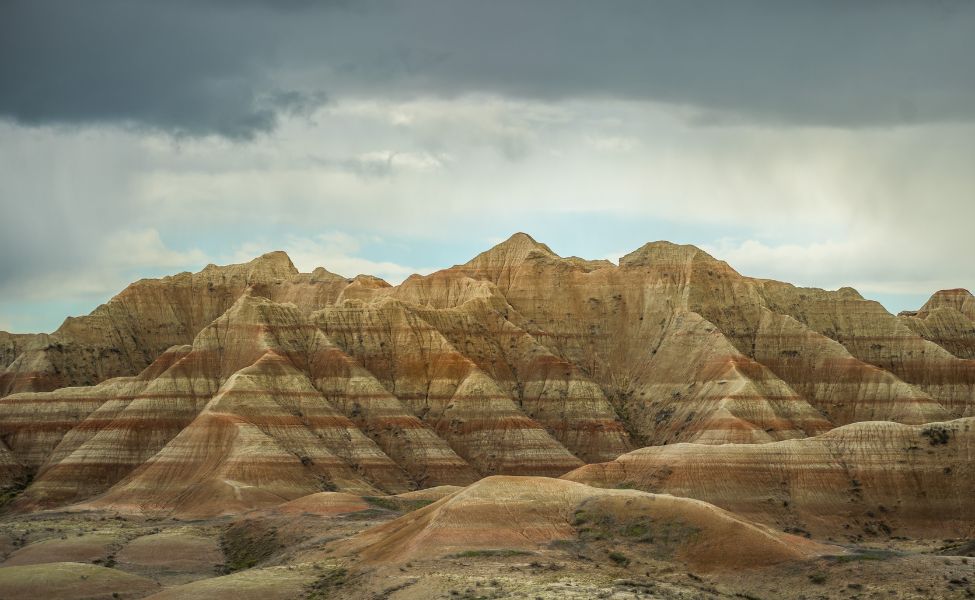
Even though the Natives of Dakota called this area mako sica, meaning bad land, we still think it's worth the visit. Badlands National Park was one of many hunting grounds of Native Americans despite dune-looking rocky terrain and a deadly mix of high temperatures and almost no water. The rocky terrain in question looks like Mars territory in a way, with formations covered in grayish and brownish strips. This area underwent quite a transformation over millions of years of existing and erosive movements. And it's still changing! An inch a year may not sound like a lot, but it's a big deal in nature talk. One of many reasons this national park is unique is the fossils that can be found on a leisure walk even today. Since the mid-1800s, Badlands was a hotspot for geologists looking for partial or whole fossils of reptiles, mammals, and even butterflies. Isn't it awesome to think you can walk on land that gives us a glimpse into such a far past? So, find yourself a friendly paleontologist or channel your inner Ross Geller to go hunting for fossils as old as 37 million years. Besides the saber-tooth cat, try to spot a whooping crane that, unfortunately, found a spot on the endangered species list.
Yellowstone National Park - Most popular national park in the USA
| Location | Northwest parts of Wyoming, Park County in Montana and Fremont County in Idaho and it has 5 entrances. |
| Size | 2,219,791 acres |
| How long does it take to tour | At least 4 days, but we recommend 5 |
| Best time to visit | To escape the crowds and have a better chance of witnessing wildlife visit it in April, September or October |
| Entrance fees | There are seven-day, annual and lifetime passes that go for $20-80, as well as camping fees. Buy and see them all on the official website Yellowstone National Park entrance fees. |

If 2012 ruined it for y'all, you need to shake it off asap. You may think its eruption is overdue, but the data clearly indicates that's not the case. But it does have almost 3,000 earthquakes every year. Anyway, why would you want to miss out on the colorful hot springs and geysers Yellowstone is famous for? There isn't any other place in the world that has that many of them! The 10,000 hydrothermal features in Yellowstone are recognizable due to their vivid orange and blue colors, which come from heat-loving microorganisms that call these waters home. Besides hot springs, mud pots, and travertine terraces, this park has almost 300 waterfalls. We suggest you climb your way to Eagle Peak, Yellowstone's highest point, to get the best photos and an even better view.
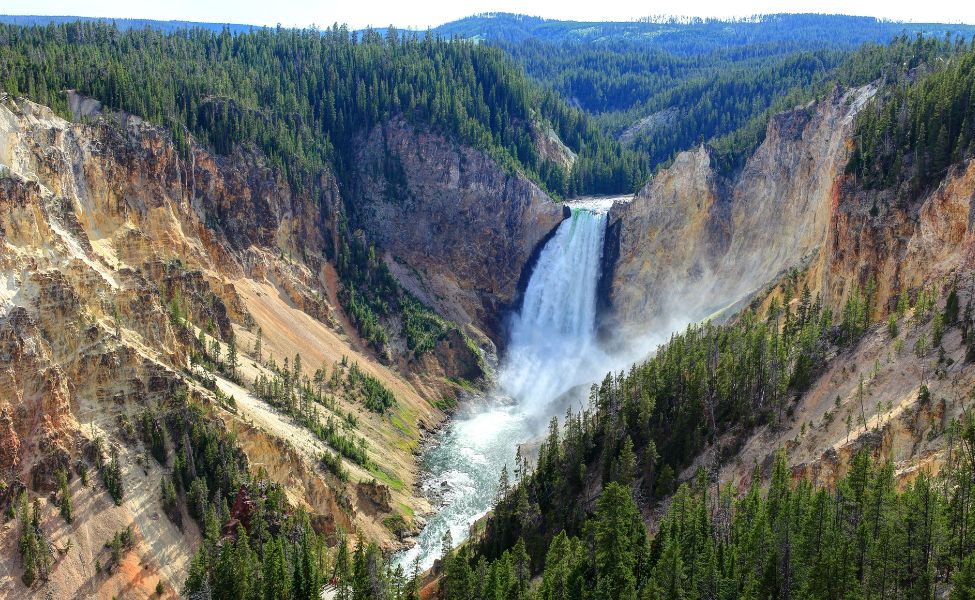
Crater lake National Park - Home of the deepest lake in the USA
| Location | Southern Oregon, Klamath County; Highway 62 can be followed to most entrances to the park, as well as Highway 138 to the North Entrance |
| Size | 183,224 acres |
| How long does it take to tour | A full day; Take at least 2 hours for a hike and enjoy a 30-minute boat ride |
| Best time to visit | The biggest crowds gather in July, August, and September, although May is the most peaceful |
| Entrance fees | Fees depend on the season and the vehicle and go from $15 to $200. Learn more about them - Crater lake National Park entrance fees |

If you've ever wanted to walk into your Pinterest feed, this is the place to be. We have to thank massive volcanic events that took place on this land over 7,700 years ago for the beauty that is the fifth-oldest national park in the USA and only in this state. Due to its climate, the snow season can last from November all the way to June, so you know where to go if you're not a summer person. You may even get lucky and see the Mazama newt. Not a Harry Potter world creature, but a type of rough-skinned newt that can only be found in this part of the world. But, the park's most impressive feature has to be the Crater Lake itself - reaching the depths of 1,943 feet; it is considered the deepest lake in all of the USA! The lake's water levels are maintained by the melting snow plus the rain, and it has a fascinating blue color. Even though it is almost freezing, there are designated areas for swimming. We say go for it!

Redwood National Park - A visit to the tallest trees in the world
| Location | Northernmost coastal California, Humboldt and Del Norte County; Easiest way to reach it is Highway 101 on Crescent City and Orick corridor |
| Size | 131,983 acres |
| How long does it take to tour | Full day for a slow-paced experience, or at least 6 hours |
| Best time to visit | The best hiking months are May-September, but if you're a pluviophile, head there during winter |
| Entrance fees | Park is free to visit, although California state parks have day-use fees covered by California state park passes |

Located in California, these 139 acres of the park are actually a complex consisting of a national park and three state parks. In 1980 it was declared a World Heritage site by UNESCO due to its rich ecosystem and cultural significance. It is widely known for the tree giants it guards - California redwood or more commonly referred to as sequoias. But, did you know these are the tallest trees in the world? And boy, are they impressive, reaching over 370 feet in height. Yes, they are taller than Lady Liberty herself. Even though more than five scenic roads take you to beaches, meadows, and narrow roads, we think it's best to explore this one on foot or go horseback riding. This is the perfect time to go tree-hugging, even though you won't be able to wrap your hands around them. Also, don't forget to go all the way to the coast to try and spot whales, seals, and colorful flowers unique to this area of America. After Redwood, go exploring other heritage sites with the help of our blog - Top 20 World Heritage Sites.

Yosemite National Park - Where waterfalls and sequoias compete for the title of the tallest
| Location | Between Stanislaus National Forest and Sierra National Forest; Tuolumne, Mariposa, Mono and Madera Counties, California. It has three entrances on Highway 120, one on Highway 140, and one on Highway 40 |
| Size | 747,956 acres |
| How long does it take to tour | 3 days if you want to go on longer hikes and explore the glaciers |
| Best time to visit | The period from June to September |
| Entrance fees | Fees vary due to the season and vehicle, but they go from $20 do $300. Find them all on the Yosemite National Park entrance fees website. |
Use the slider to witness the magic
When he was writing his docu-series and book that convey all the intricacies of national parks in America, author Dayton Duncan recorded a quote that reads:
A man came up to Yosemite, and the ranger was sitting at the front gate, and the man said: I've only got one hour to see Yosemite. If you only had one hour to see Yosemite, what would you do?
And the ranger said - Well, I'd go right over there, and I'd sit on that rock, and I'd cry.
And it pretty much sums it up. There are over 25 waterfalls in Yosemite, most of them as tall as New York skyscrapers, Yosemite Falls being the highest at 2,425 feet (739 m!). Sticking with the theme, you can find sequoias in Yosemite as well, although not as tall as in Redwood. The famous Firefall that occurs every February in Yosemite is finally back, and you too can witness this collaboration of sun and water that makes it seem like fire is flowing down the rocks.

Death Valley National Park - Ready to face the Earth's highest temperatures?
| Location | California-Nevada border, including sections of Panamint, Eureka, and most of Saline Valley; It has five official entrances |
| Size | 3,373,063 acres |
| How long does it take to tour | 2 full days to see all the best spots |
| Best time to visit | avoid.summer.at.all.costs. / Busiest periods are November-March |
| Entrance fees | Depend on the vehicle and go from $15 to $30. See them all here - Death Valley National Park entrance fees |
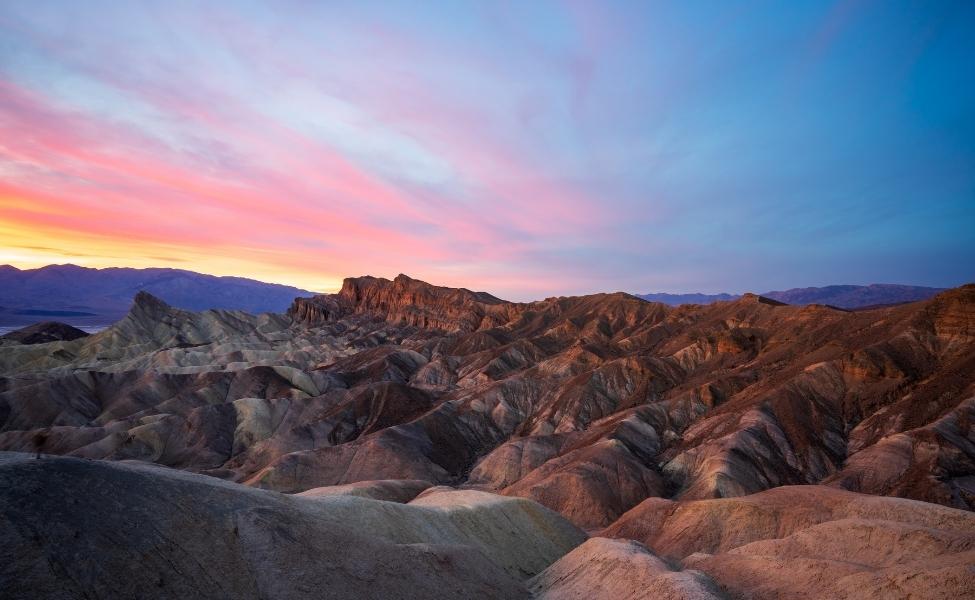
If you've always wanted to see tumbleweed and live out your best western fantasies, Death Valley is the place to go. Even though it sounds like Hell on Earth, we still love it. This is due to excruciatingly high temperatures that haunt these areas. Did you know that Death Valley is the place with the highest registered air temperature on Earth? Immense 134F (56.7c) was breaking the thermometers way back in 1913. If you decide to visit it today, it is best to go later in the day. From May to September, even the lowest temperatures don't go under 75F, so good luck. The park is gorgeous nonetheless. Numerous sand dunes transport you to Arrakis, an area called The Racetrack, which you can explore in a vehicle, and colorful hard-packed ridges called Zabriskie Point at the end of the 7.8-mile hiking trail.
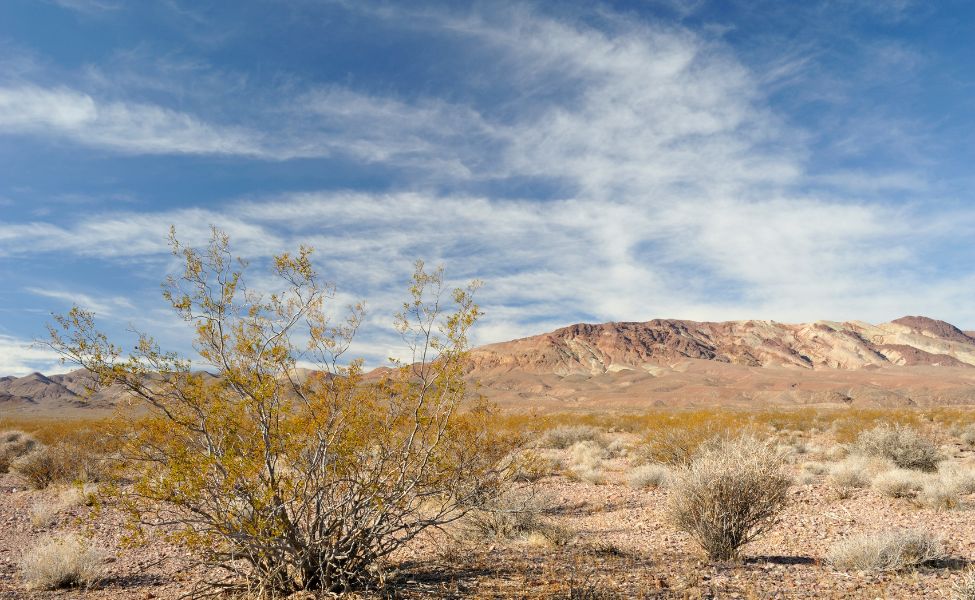
Famous US national park - Grand Canyon
| Location | Northwestern Arizona, on Coconino and Mohave counties; It has three rims and can be accessed coming from both Arizona and Utah. |
| Size | 1,217,262 acres |
| How long does it take to tour | 2 full days, or 3 if you want to indulge in more hikes and enjoy a slow-paced sightseeing tour |
| Best time to visit | The weather is best during Spring, April to June |
| Entrance fees | From $20 to $30 depending on the vehicle and time of your stay; Find and book them on the Grand Canyon National Park entrance fees website |

Grand Canyon speaks for itself as a testimony to Earth's changing nature, but that won't stop us from fangirling over it. Even though it isn't the biggest canyon in the world, it is still huge. Bigger than Rhode Island, to be a bit more precise, and plummeting to 2-mile depths. Due to drastic and sudden changes in elevation, the park makes its weather, which means you can experience almost all seasons if you explore it long and wide enough. Another fascinating but also kinda sad fact about it is that the dinosaurs didn't get to roam around it - the rocks that make the canyon are older than the dinos, but the canyon formation isn't. Either way, there have been numerous fossil findings in the Grand Canyon over the years, dating back 1.2 billion years.

Honorable mentions - Other famous national parks in the USA to give a chance to
So, we feel kinda bad for not mentioning more parks for you to explore, hence these honorable mentions. From stunning nature to exciting activities, find some time to pay a visit to:
- Acadia National park - Located on Main's coast, this park is blessed with unique cliffs and beaches, typical for this region. It's especially stunning during Autumn, as the trees it is covered in create the perfect pre-Halloween aesthetic. If winter is more your speed, Acadia offers terrain perfect for cross-country skiing and snowshoeing. If this isn't the perfect winter vacation destination, we don't know what is.
- Indiana dunes National park - Located in Indiana, this national park covers over 15,000 acres and is not only known for, spoiler alert, sand, but also for many creeks and lakes that call it home. This is where you'll find some of the biggest lakeshore dunes in the world, beaches on Lake Michigan, a variety of snakes, and some interesting sparrows. For some well-deserved solitude, visit it during spring vacation.

- Zion National park - This so-called expansive canyon is situated in the southwestern part of Utah. If you're an avid hiker, this is the place to be. There is a particular part of the Canyon known as The Subway that can be challenging even for the most experienced hikers. Don't say we didn't warn you! After a long day in 2,000 feet deep floors, you can freshen up in the Virgin River.
- Grand Teton National park - Now, if you go mountaineering in this postcard-worthy national park, there's a big chance you'll be in the presence of a bear, moose, bison, or maybe even a cougar. It is one of the most famous national parks in Wyoming, mostly loved for its spectacular wildlife.
- Joshua tree National park - Rock climbers, this one is for you. If you're on your way to Los Angeles, you cannot miss this national park spreading over 795 acres. Joshua tree is home to two deserts, the Mojave and Colorado, as well as over 8,000 climbing routes! Good luck choosing your favorite.
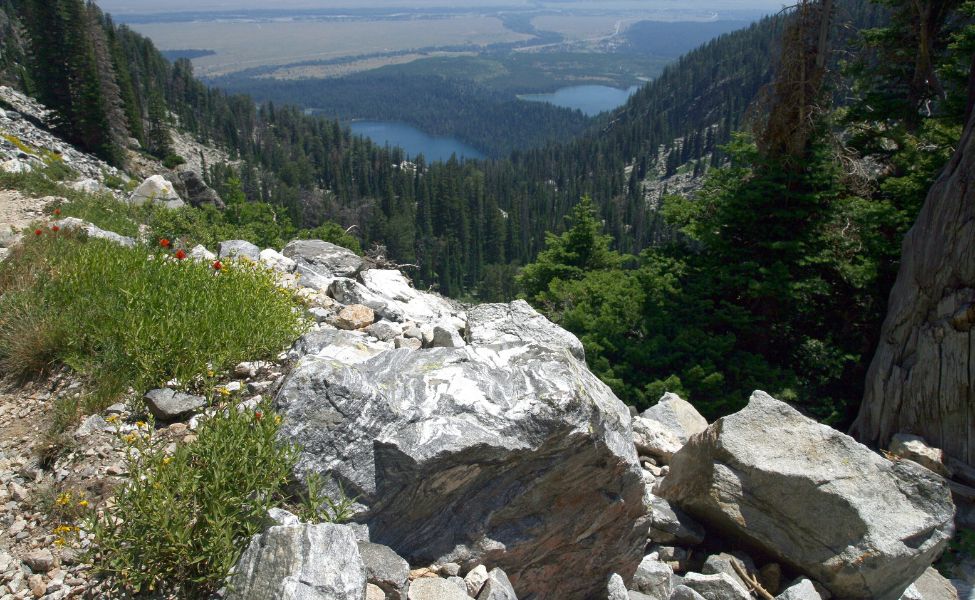
Map of national parks in the USA
Before we leave you to it, here's a map that shows all before mentioned parks. It's great for trip planning, as you can see routes, distances, and nearby attractions. And it's pretty! Have fun exploring it.
Well, you've learned how many national parks are in the US, where to find them, and what to expect. Even if you're not an outdoorsy person, you will love them, we are sure of it. Are you already off on your first adventure? Cause we sure are!



